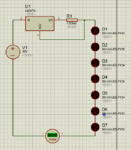Audioguru
Advanced Member level 7

- Joined
- Jan 19, 2008
- Messages
- 9,461
- Helped
- 2,152
- Reputation
- 4,304
- Reaction score
- 2,011
- Trophy points
- 1,393
- Location
- Toronto area of Canada
- Activity points
- 59,764
Without seeing the datasheet for the UV LEDs, I wonder if the 700mA is the absolute maximum allowed current if they have perfect cooling? How will you cool them? With a spray of Liquid Nitrogen? Then the thermal extremes will kill them soon.
I agree that the You Tube video is completely wrong. The hFE of a transistor that you buy can be 50 or 300 or anything in between and it changes with temperature and current changes. The circuit would probably burn out at least one of the series LEDs then they all would not produce any light.
I agree that the You Tube video is completely wrong. The hFE of a transistor that you buy can be 50 or 300 or anything in between and it changes with temperature and current changes. The circuit would probably burn out at least one of the series LEDs then they all would not produce any light.


